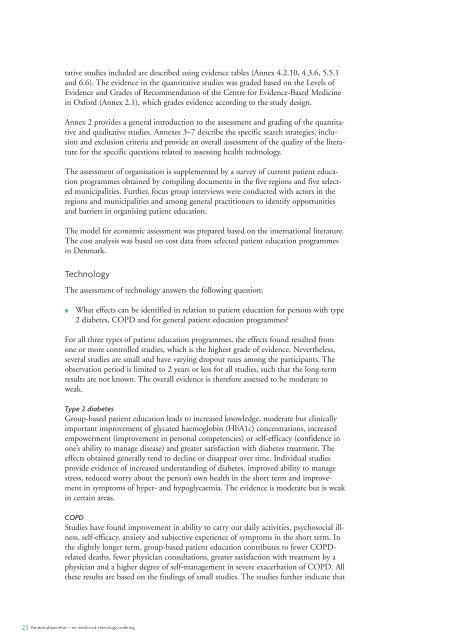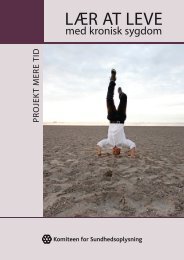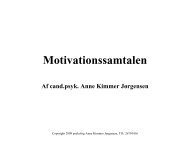- Page 1 and 2: Patientuddannelse - en medicinsk te
- Page 3 and 4: Indhold Hvad er MTV 7 Sammenfatning
- Page 5 and 6: 7.3 Samfundsøkonomiske omkostninge
- Page 7 and 8: Hvad er MTV MTV er et redskab, der
- Page 9 and 10: I et afsnit om metodekritik diskute
- Page 11 and 12: Generel patientuddannelse Gruppebas
- Page 13 and 14: cielt sygdomsudbrud - bedre og mere
- Page 15 and 16: ■■ Hvad er de internationale er
- Page 17 and 18: ■■ Hvad er de kasseøkonomiske
- Page 19 and 20: programmer, men på et overordnet p
- Page 21: Summary The boundaries between the
- Page 25 and 26: For general patient education, only
- Page 27 and 28: adapted to each person’s situatio
- Page 29 and 30: framework does not ensure that all
- Page 31 and 32: od after the intervention ended. Fu
- Page 33 and 34: Demographic projections for Denmark
- Page 35 and 36: Projektgruppen Redaktionsgruppen To
- Page 37 and 38: Jane Tribler Chefkonsulent, MPH Afd
- Page 39 and 40: Læsevejledning Denne MTV kan læse
- Page 41 and 42: Ordliste CDSMP Egenomsorg Empowerme
- Page 43 and 44: 1 Introduktion 1.1 Baggrund for pro
- Page 45 and 46: dre vigtige, men at det vil være f
- Page 47 and 48: ■■ ■■ ■■ Hvilke former
- Page 49 and 50: 2 Patientuddannelse - kronisk sygdo
- Page 51 and 52: 2.2.1 Genoptræning Genoptræning e
- Page 53 and 54: I forbindelse med patientuddannelse
- Page 55 and 56: 3 Teknologi Effekten af og virkning
- Page 57 and 58: effekterne på tværs af de inklude
- Page 59 and 60: To oversigtartikler og tre primære
- Page 61 and 62: 3.3.2.5 Effekt på forbrug af sundh
- Page 63 and 64: sigt. Undersøgelserne omhandler gr
- Page 65 and 66: kognitive symptomhåndteringsstrate
- Page 67 and 68: Langt de fleste undersøgelser er u
- Page 69 and 70: 3.5 Teoretisk grundlag og pædagogi
- Page 71 and 72: symptomerne på, ligesom deltagerne
- Page 73 and 74:
at underviserne har en kronisk sygd
- Page 75 and 76:
Den begrænsede evidens, traditione
- Page 77 and 78:
3.7 ■■ Sammenfatning Hvilken ef
- Page 79 and 80:
personer med kronisk sygdom, der un
- Page 81 and 82:
i patientuddannelsesprogrammer kan
- Page 83 and 84:
men havde intet udbytte i forhold t
- Page 85 and 86:
Det er desuden uklart, om det er pa
- Page 87 and 88:
idet interviewpersonerne er fundet
- Page 89 and 90:
Forfatterne foreslår, at der har v
- Page 91 and 92:
dem. Især peges der på, at en del
- Page 93 and 94:
nelsesindholdet ifølge deltagerne
- Page 95 and 96:
■■ Inddragelse af psykoterapeut
- Page 97 and 98:
sådanne materialer og vejledningen
- Page 99 and 100:
Desuden må empowermentstrategier a
- Page 101 and 102:
5.3.1 Alternative effektmål Review
- Page 103 and 104:
5.4 Sammenfatning Dette kapitel bel
- Page 105 and 106:
EPP blev introduceret i det engelsk
- Page 107 and 108:
tiserende læger til at anerkende f
- Page 109 and 110:
tionsanalysen, at der i regioner og
- Page 111 and 112:
for en særlig udredning eller en k
- Page 113 and 114:
Arbejdsdelingen mellem region og ko
- Page 115 and 116:
Man forsøger at komme dertil, hvor
- Page 117 and 118:
Region Nordjylland og de nordjyske
- Page 119 and 120:
Der er desuden forskel på, hvor la
- Page 121 and 122:
Fælles for patientuddannelserne i
- Page 123 and 124:
6.4.3.2 Regionale og kommunale stra
- Page 125 and 126:
er, hvordan får vi det bedste forl
- Page 127 and 128:
noget, som har været vores, og så
- Page 129 and 130:
Endelig peger de kommunale responde
- Page 131 and 132:
CDSMP og strukturreformen er der sa
- Page 133 and 134:
For det fjerde viser analysen også
- Page 135 and 136:
På længere sigt vil det være vig
- Page 137 and 138:
■■ ■■ ■■ ■■ I de sy
- Page 139 and 140:
7 Økonomi I forbindelse med denne
- Page 141 and 142:
Organisationskapitlet i denne rappo
- Page 143 and 144:
værdien af tid for personer uden f
- Page 145 and 146:
Omkostningen ved selve undervisning
- Page 147 and 148:
Tabel 7.5 Omkostninger pr. deltager
- Page 149 and 150:
Tabel 7.6 Beregnede gennemsnitsomko
- Page 151 and 152:
7.4.3 Generel patientuddannelse De
- Page 153 and 154:
7.6.1 Udgifter Beregningen af udgif
- Page 155 and 156:
■■ ■■ ■■ Pr. indlæggel
- Page 157 and 158:
de vil der også være en betydelig
- Page 159 and 160:
For sygehusene er det muligt umidde
- Page 161 and 162:
effekt af uddannelser, der anvender
- Page 163 and 164:
■■ ■■ At der sikres flervid
- Page 165 and 166:
15. Sundhedsstyrelsen. KOL - kronis
- Page 167 and 168:
42. Sixta CS, Ostwald S. Texas-Mexi
- Page 169 and 170:
68. Gallefoss F, Bakke PS, Rsgaard
- Page 171 and 172:
96. Beck A. Cognitive theory and th
- Page 173 and 174:
124. Hayes E, McCahon C, Panahi MR,
- Page 175 and 176:
152. Layh K, Reintjes R. [The influ
- Page 177 and 178:
178. Gucciardi E, Wang SC, DeMelo M
- Page 179 and 180:
209. Welch J, Fisher ML, Dayhoff NE
- Page 181 and 182:
239. Bourbeau J, Julien M, Maltais
- Page 183 and 184:
267. Rea H, McAuley S, Stewart A, L
- Page 185 and 186:
292. Schinaman SA. Psychological in
- Page 187 and 188:
317. Two Feathers J, Kieffer EC, Pa
- Page 189 and 190:
341. McLean DL, McAlister FA, Johns
- Page 191 and 192:
366. Mitton C, O’Neil D, Simpson
- Page 193 and 194:
392. Lorig KR, Sobel DS, Stewart AL
- Page 195 and 196:
419. Zoffmann V, Lauritzen T. Guide
- Page 197 and 198:
446. Green A, Emneus M, Christianse
- Page 199 and 200:
Bilag 1.2 Empowerment Begrebet empo
- Page 201 and 202:
Bilag 2: Introduktion til litteratu
- Page 203 and 204:
Bilag 2: - Tabel 2.1: Evidensniveau
- Page 205 and 206:
duktion af data, teoretisk ramme, a
- Page 207 and 208:
■■ ■■ ■■ ■■ ■■
- Page 209 and 210:
UK: NCCHTA til 27. februar 2009 USA
- Page 211 and 212:
Bilag 4.2.3 Vurdering af inkludered
- Page 213 and 214:
Bilag 4.2.5 Udvælgelsesprocessen a
- Page 215 and 216:
Bilag 4.2.7 Karakteristik af eksklu
- Page 217 and 218:
Artikel Årsag til eksklusion ved g
- Page 219 and 220:
Artikel The Look AHEAD Research gro
- Page 221 and 222:
Studie SBU 2009 (17) Effektmål og
- Page 223 and 224:
Studie Vincent 2009 (44) Song 2006
- Page 225 and 226:
Studie Mayer- Davis 2004 (49) Cheye
- Page 227 and 228:
Bilag 4 - Tabel 4.9: Effekten af gr
- Page 229 and 230:
Studie Skumlien 2007 (62) Antal del
- Page 231 and 232:
Studie Behandlingseffekt Bendstrup
- Page 233 and 234:
Studie Scott 2004 (74), Beck 1997 (
- Page 235 and 236:
Bilag 4.2.10 Evidenstabeller til kv
- Page 237 and 238:
Bilag 4 - Tabel 4.13: Evidenstabel
- Page 239 and 240:
Studie (forfatter, forfattertitel,
- Page 241 and 242:
Studie (forfatter, forfattertitel,
- Page 243 and 244:
Studie (forfatter, forfattertitel,
- Page 245 and 246:
Studie (forfatter, forfattertitel,
- Page 247 and 248:
Studie (forfatter, forfattertitel,
- Page 249 and 250:
Studie (forfatter, forfattertitel,
- Page 251 and 252:
Studie (forfatter, forfattertitel,
- Page 253 and 254:
Studie (forfatter, forfattertitel,
- Page 255 and 256:
Studie (forfatter, forfattertitel,
- Page 257 and 258:
Studie (forfatter, forfattertitel,
- Page 259 and 260:
Bilag 4 - Tabel 4.16: Evidenstabel
- Page 261 and 262:
Studie (forfatter, forfattertitel,
- Page 263 and 264:
Studie (forfatter, forfattertitel,
- Page 265 and 266:
Studie (forfatter, forfattertitel,
- Page 267 and 268:
Bilag 4.3.3 Specifik søgning Der e
- Page 269 and 270:
Bilag 4 - Tabel 4.18: Type 2-diabet
- Page 271 and 272:
Anderson-Loftin 2005 (47) Toobert e
- Page 273 and 274:
Bilag 4 - Tabel 4.19: KOL - teori,
- Page 275 and 276:
Bilag 4.3.5 Samlet bedømmelse (ske
- Page 277 and 278:
Bilag 4.3.6 Evidenstabel - teori, p
- Page 279 and 280:
Studie (forfatter, forfattertitel,
- Page 281 and 282:
Studie (forfatter, forfattertitel,
- Page 283 and 284:
Det meget store antal fund blev scr
- Page 285 and 286:
# Query Limiters/Expanders Last Run
- Page 287 and 288:
attitudes” or ”teacher attitude
- Page 289 and 290:
Forfatter Titel Eksklusionsårsag R
- Page 291 and 292:
Bilag 5.5.1 Evidenstabel - kvalitat
- Page 293 and 294:
Studie (forfatter, forfattertitel,
- Page 295 and 296:
Bilag 6: Organisation Bilag 6.1 Org
- Page 297 and 298:
Bilag 6.5 Samlet bedømmelse (skema
- Page 299 and 300:
Bilag 6.7 Primær dataindsamling Me
- Page 301 and 302:
egioner og kommuner, som beskriver
- Page 303 and 304:
Bilag 6 - Tabel 6.3: Arbejdsplan fo
- Page 305 and 306:
the National Health Service (NHS).
- Page 307 and 308:
Bilag 6.9.1.2 Patientuddannelser i
- Page 309 and 310:
Antal deltagere pr. hold Hvem er an
- Page 311 and 312:
Diabetes (ikke startet på KOL-forl
- Page 313 and 314:
Sygehus Målgruppe Omfang Indhold S
- Page 315 and 316:
Bilag 6 - Tabel 6.9: Oversigt over
- Page 317 and 318:
Hvem er underviserne, og hvilke ins
- Page 319 and 320:
I nedenstående Tabel 6.10 er indho
- Page 321 and 322:
Der er flere forskelle på de to ge
- Page 323 and 324:
Bilag 6 - Tabel 6.12: Oversigt over
- Page 325 and 326:
Uddannelsen er afprøvet i Ribe og
- Page 327 and 328:
Bilag 7: Økonomi Bilag 7.1 Littera
- Page 329 and 330:
I alt identificeres 26 studier af o
- Page 331 and 332:
Omkostningerne er generelt lave, fr
- Page 333 and 334:
Foster et al. (2007) Foster et al.
- Page 335 and 336:
Ad 2. Andet ressourceforbrug Der re
- Page 337 and 338:
Underviserne vurderes derudover at
- Page 339 and 340:
Deltagerne vil typisk før, under e
- Page 341 and 342:
Hvis der for hver deltager tillægg
- Page 343 and 344:
practice mv. Tidsforbruget er vansk
- Page 345 and 346:
med ca. otte timers undervisning pr
- Page 347 and 348:
Bilag 7.5.2.4.4 Deltagernes tidsfor
- Page 349 and 350:
Bilag 7.5.2.5.2 Andet ressourceforb







